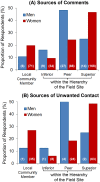Survey of academic field experiences (SAFE): trainees report harassment and assault
- PMID: 25028932
- PMCID: PMC4100871
- DOI: 10.1371/journal.pone.0102172
Survey of academic field experiences (SAFE): trainees report harassment and assault
Abstract
Little is known about the climate of the scientific fieldwork setting as it relates to gendered experiences, sexual harassment, and sexual assault. We conducted an internet-based survey of field scientists (N = 666) to characterize these experiences. Codes of conduct and sexual harassment policies were not regularly encountered by respondents, while harassment and assault were commonly experienced by respondents during trainee career stages. Women trainees were the primary targets; their perpetrators were predominantly senior to them professionally within the research team. Male trainees were more often targeted by their peers at the research site. Few respondents were aware of mechanisms to report incidents; most who did report were unsatisfied with the outcome. These findings suggest that policies emphasizing safety, inclusivity, and collegiality have the potential to improve field experiences of a diversity of researchers, especially during early career stages. These include better awareness of mechanisms for direct and oblique reporting of harassment and assault and, the implementation of productive response mechanisms when such behaviors are reported. Principal investigators are particularly well positioned to influence workplace culture at their field sites.
Conflict of interest statement
Figures



Comment in
-
Female astronomers of colour face daunting discrimination.Nature. 2017 Jul 11;547(7663):266-267. doi: 10.1038/nature.2017.22291. Nature. 2017. PMID: 28726835 No abstract available.
References
-
- Lock R (1998) Fieldwork in the life sciences. International Journal of Science Education 20: 633.
-
- Raymond GWGS, Wheeler P, Scott LJ, Tobin ML, Marsham S (2012) The Value of Fieldwork in Life and Environmental Sciences in the Context of Higher Education: A Case Study in Learning about Biodiversity. Journal of Science, Education, and Technology 21: 11.
-
- McGuire KL, Primack RB, Losos EC (2012) Dramatic improvements and persistent challenges for women ecologists. BioScience 62: 189–196.
-
- Clark JN (2012) Fieldwork and its Ethical Challenges: Reflections from Research in Bosnia. Human Rights Quarterly 34: 823–839.
-
- Keashly L, Neuman JH (2010) Faculty experiences with bullying in higher education. Administrative Theory & Praxis 32: 48–70.
Publication types
MeSH terms
Grants and funding
LinkOut - more resources
Full Text Sources
Other Literature Sources

